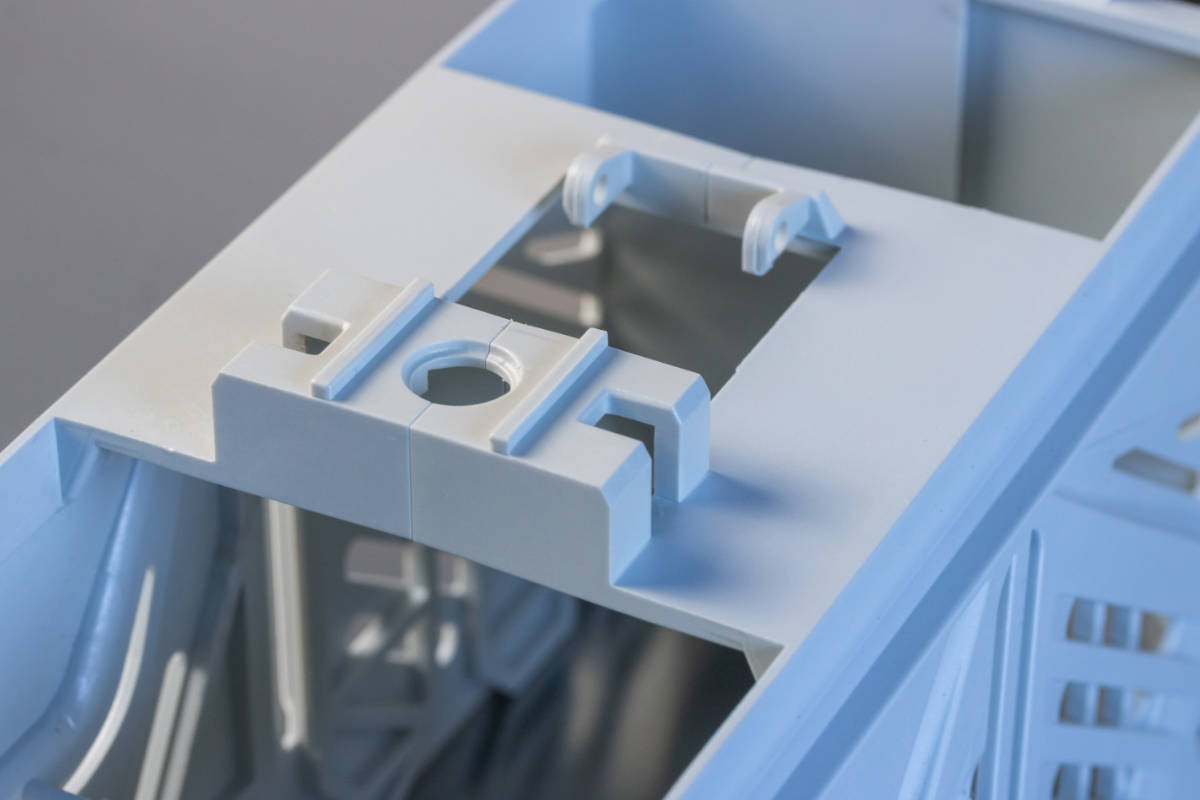Injection molding
Plastic injection molding components & solutions
We have built up a modern and innovative infrastructure in order to be able to implement special customer-specific solutions at short notice. We produce for various industries whose economic development does not run in parallel, so it is important for us to be able to act flexibly. Production takes place around the clock (24h / 3-shift operation) and is usually fully automated.
This means very short lead times for our customers: from order to delivery!
2-component injection moulding
40 years of experience in plastic injection moulding have made us specialists in multi-component technology. We find solutions for your products using different plastics or plastic-metal combinations – this means that in the 2-component injection moulding process, we process two different plastics simultaneously in one mould. The advantage is obvious – different materials can be used to fulfil different functions, combined in a single component. We use our tools to create both hard/hard and hard/soft combinations. The possibilities range from moulded seals to 2-component MID components.
Machinery
State-of-the-art injection moulding machines are required to produce market-ready, high-quality products. We work with 26 injection moulding machines from Engel, Demag, Battenfeld and Fanuc (horizontal and vertical machines). Twenty-one injection moulding machines (from 50 to 800 tonnes) are largely fully automatic and equipped with handling systems (injection weight 1 g – 2000 g). Six 2-component injection moulding machines (from 80 to 200 tonnes) can be used with rotary table, index plate and transfer processes, and two 100-tonne electric injection moulding machines are also available. This enables us to offer you a high degree of flexibility for both large and small series.
Injection moulding is one of the most common primary moulding processes for manufacturing plastic parts, which we can also offer you thanks to our 30 years of experience in this field. The process enables you as a customer and us as manufacturers to produce plastic injection moulded parts in countless shapes, colours, patterns and surface structures. Even large series of parts can be produced without any problems using our tools.
What is injection moulding?
Injection moulding is a process used to manufacture plastic items. These are primarily industrial goods, such as housings for household appliances, toys or essential automotive components such as bumpers and dashboards. Plastics such as thermoplastics, duromers and elastomers are processed at different temperatures and pressures during the manufacturing process. Fillers such as glass or natural fibres may also be added to improve the properties of the finished product.
Typical plastics include polypropylene, which is used in car bumpers, polycarbonate, which is used for headlights thanks to its transparency, and polyamide, which is used in toy manufacturing. Using the injection moulding process, we can produce small injection-moulded parts measuring just a few millimetres in size, as well as large plastic injection-moulded parts weighing up to 150 kilograms, each of which requires only minimal post-processing.

The production of injection moulded parts
Our injection moulding process consists of six individual steps, which together produce the desired plastic injection moulded parts. First, the plastic is plasticised or melted. To do this, the plastic granulate you want as a customer is poured through a hopper into the screw of the plasticising unit. This long, spiral-shaped module of the injection moulding machine rotates and has heating bands that heat the granulate to a pre-set temperature.
This liquefies and homogenises the plastic and transports it forward towards the mould. The screw, which is flexibly mounted at the front and rear, moves further back as more plastic accumulates in the front area behind the injection nozzle (collection chamber). If you press the switch at the end of the screw housing, the feed and metering are stopped.
The required amount of plastic is precisely metered via the screw tip and under the injection pressure generated by the movement of the screw and injected into the cavity via the sprue bushing. This is the space between the two halves of the mould that is to be filled with liquid plastic.
We fill the mould at a speed that is adapted to the respective plastic. We take care to fill it as quickly as possible at first, then fill it up at a slowly decreasing speed using the holding pressure method. In this way, we prevent material shrinkage, air pockets and the associated reduction in the quality of the finished injection-moulded parts. In this context, high clamping forces and, if necessary, a larger injection volume are required, especially for large plastic injection moulded parts.
We then allow the plastic injection moulded parts to cool or cross-link and harden in the process. Depending on the size and desired wall thickness, this step can take from a few seconds to several minutes. Once the desired status of the injection moulded parts has been achieved, the mould opens and releases the part we have moulded according to your specifications in the sixth and final step. This is also referred to as the "demoulding" of the injection moulded part. The process then begins again.

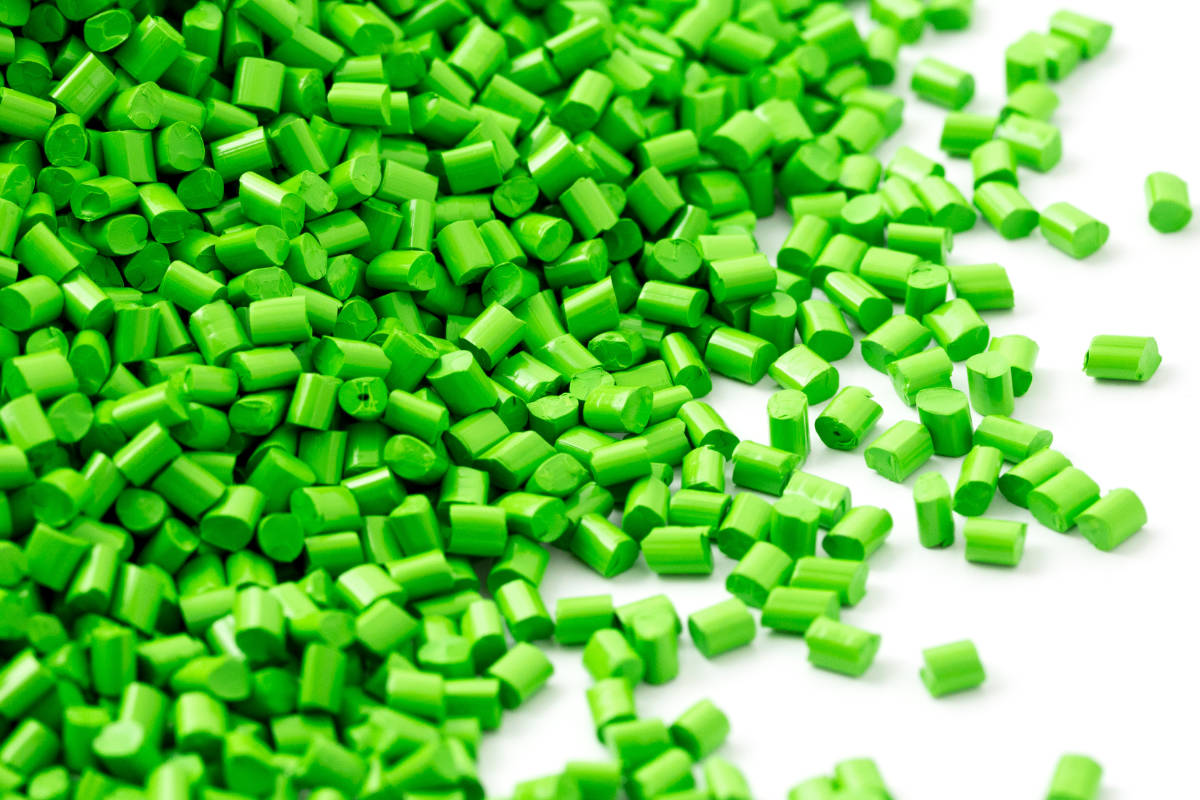

We use these tools to manufacture plastic injection moulded parts
We use screw injection moulding machines to manufacture small and large plastic injection moulded parts. These are available as single-component versions and as two-component machines. Unlike the former, the latter are capable of producing different types of plastic or injection moulded parts consisting of individual elements in different colours.
Our injection moulding machines feature automatic shutdown and start-up programmes as well as cycle analysis and display options. Thanks to state-of-the-art software, they are also capable of performing error analyses and self-diagnoses independently and recording the necessary process data. This allows us to individually adjust, control and save the production parameters you specify – around the clock and usually fully automatically. This also means you can expect very short throughput times per series.
The machines can basically be divided into three units. The injection or plasticising unit comprises a hopper into which the plastic granulate is fed, a horizontal cylinder containing the screw and the actual injection nozzle. The plasticising unit is therefore responsible for receiving, melting, transferring and injecting the plastic into the mould.
This, in turn, is located in the next injection moulding machine assembly, which we also refer to as the clamping unit. The injected plastic enters a cavity in the actual moulding tool. This space is also referred to as the cavity and gives the plastic injection moulded part its shape and the surface structure you, the customer, desire. To do this, we create the cavity as a negative mould of the finished object. The side of the clamping unit adjacent to the plasticising unit is rigid, while the other side can be moved electromechanically or hydraulically. Once the injection-moulded parts have hardened in the cavity, the outer side can be opened and the components released.
Both main units are mounted on the machine bed or machine stand. This enables the controlled transport and closing mechanisms and contains the control cabinet and the machine motor. The control panel is also attached to the stand of the injection moulding machine.
Our machines are manufactured by Demag, Engel, Fanuc and Battenfeld and come in different sizes and specialise in different areas. Our machine park includes smaller 50 to 100 tonne injection moulding machines, as well as large models of up to 800 tonnes. This enables us to manufacture both miniature plastic parts and large plastic injection moulded parts in various series sizes.
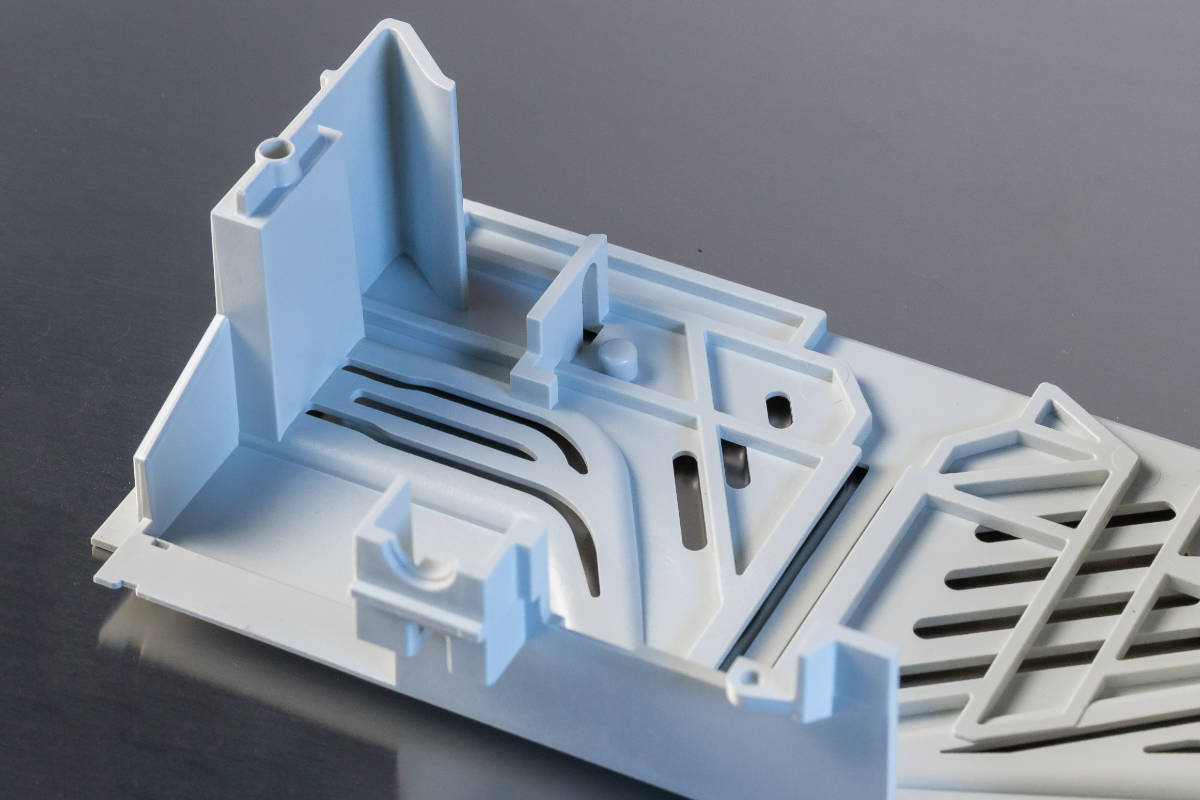
What factors determine the cost of manufacturing your plastic injection moulded parts?
In principle, a single tool can be used to manufacture thousands of parts or more, which can result in extremely advantageous cost distribution. However, if you need several different tools for smaller series of parts, the total costs may be correspondingly higher. This is due in particular to the high complexity of the tools and the precision with which they are manufactured in order to withstand the mechanical and thermal stresses prevailing during the injection moulding process.
The complexity of the parts to be manufactured and special requirements for the surface structure can also influence costs. The same applies to the size of the individual components, as large plastic injection moulded parts naturally require more material and more extensive planning.
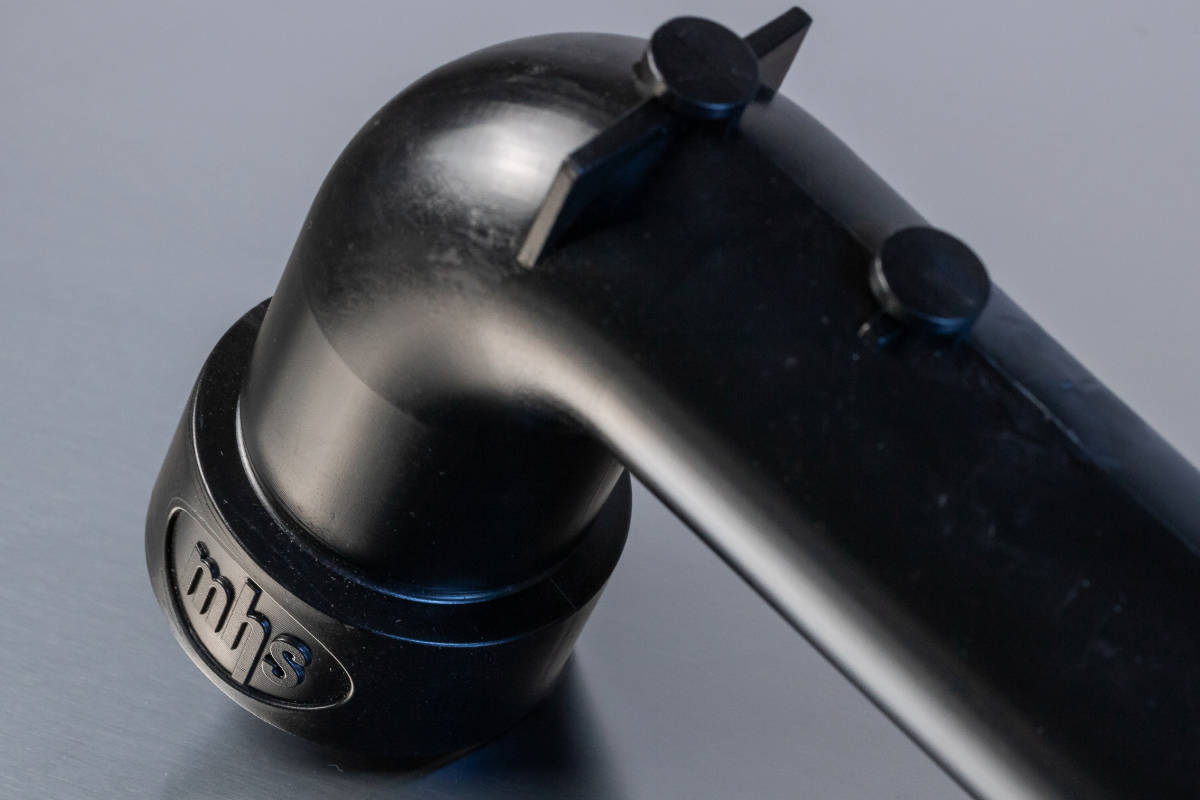
Precision injection moulded parts
Manufacturer of plastic components & precision injection moulded parts in Austria
With more than three decades of experience in the field of plastics technology and multi-component manufacturing, you can expect the highest level of expertise when you work with us. Our team of over 90 highly qualified employees reliably manufactures customised plastic components using established injection moulding processes, with a particular focus on delivering on time. Below, we present various areas of application and options for the manufacture of precision injection moulded parts and plastic components.
Wide range of applications
Our company has many years of extensive experience in the field of injection moulding for the manufacture of all types of plastic components. Without most people actually being aware of it, we constantly come into contact with products made of plastic components in our everyday lives.
We encounter them in the form of car headlights, safety plugs for PCs, or modular plastic systems for children. Plastic components have become indispensable in many industries, including:
- Automotive, electrical and packaging industry
- Household appliance and toy manufacturing
- Agricultural, industrial, laser, medical, furniture and surveying technology
- Mechanical engineering
The three classifications of injection moulded parts
Plastic components manufactured using injection moulding can be divided into three categories:
- A components - precision injection molded parts require maximum precision with minimum dimensions; used, for example, in medical and laser technology;
- B components - highly sophisticated, technical products; used, for example, in the automotive industry (e.g. dashboard elements). e.g. elements of the dashboard)
- C-components - relatively simple plastic products with high durability requirements; use: for example in toy manufacturing
Unlike conventional or large plastic injection moulded parts, micro or precision injection moulded parts are particularly small and usually only measure a few micrometres or millimetres in size. This means that extreme precision is essential during the injection process. The throughput times of a production cycle for precision injection moulded parts are particularly short, as rapid cooling and demoulding are possible.



Plastic workpieces vs. metal components
Plastic components offer numerous advantages over metal components. Modern high-tech materials have excellent physical properties that are otherwise mainly reserved for metals. Aluminium, brass and zinc can therefore be easily replaced by more cost-effective and extremely high-performance plastics. These have a lower weight and feature corrosion-resistant surfaces that require little or no post-treatment after demoulding. They are also ideal for insulating conductive components.

Standard process for manufacturing plastic components
The various types of injection moulding, depending on the plastics used, generally follow a similar process. First, plastic granulate is fed into a rotating screw. There it is heated and melted. High pressure forces the material into the mould cavity, where it cools and ultimately solidifies. After a relatively short cooling time, the core of the injection-moulded part also hardens. The injection-moulded parts are then automatically ejected.
As a specialist company, we have numerous injection moulding machines at our disposal to meet our customers' individual requirements in terms of weight class and quality at all times. We manufacture customised plastic components weighing from a few milligrams up to 150 kilograms.
Each material requires individual temperatures
Thermoplastics are used in most cases for the production of injection moulded parts. These are plasticised (melted) by heating and are often processed using the standard injection moulding process. Alternatively, thermosets or elastomers can also be used. Unlike thermoplastics, thermosets harden when heated. For this reason, they are injected in liquid form at medium temperature. The temperature is increased to 130 to 250 degrees Celsius for curing.
In general, it is necessary to pay attention to the different temperatures of the injected mass and the clamping unit. Below, we present further possible procedures for the explicit production of plastic components and precision injection moulded parts.
Extrusion injection moulding
Beverages such as lemonade or mineral water are usually bottled in plastic bottles. These are so-called PET bottles (PET = polyethylene terephthalate), which are available in both disposable and reusable versions. Like many other products, they are manufactured using a process known as extrusion injection moulding. Under high pressure, the liquid plastic mass is pressed through a slit or narrow opening. It takes on the shape of the workpiece, but forms it as a hollow space.
We extend this principle in plastic injection moulding by injecting the liquid component. Injection moulding machines based on a relatively complex design are available for this purpose. A slide creates the cavity in which the complete geometry of the workpiece is preformed. During the injection stage, it moves past the injection opening. It is important that the movement of the slide is precisely matched to the flow velocity of the plastic. Once this stage is complete, a second injection process fills and moulds the end area. Finally, the slide moves back, allowing the plastic component to cool completely. It can then be removed.
Multi-component injection moulding
The multi-component injection moulding process allows classic and precision injection moulded parts to be produced one after the other. This means that we add a second component to one that has already been inserted. When they meet, precisely preset temperatures ensure a kind of welding process, which is partially supported by bonding agents. This allows us to produce particularly stable structures, which are used in bicycle helmets, for example. There are also systems that have two cavities. These allow two components to be injected separately. The advantage of this is that the first component can already cool down while the second is injected at a temperature independent of the first.
The back moulding of plastic with metal foils is considered a subtype of the multi-component injection moulding process. In this process, we insert very fine metal foils with an adhesive agent so that they are pressed into the plastic component. In this way, they take on the shape of the component. The aim is to achieve secure stabilisation and a metallic feel.
Cavity injection moulding
In this process, we introduce either aqueous components or gases into the mould cavity. After the process, these flow out or escape. The result is injection-moulded parts with precisely calculated cavities. When distributed widely within the plastic, the result resembles a foam structure. This thermoplastic foam moulding is used for the production of components that are designed to offer the possibility of volume reduction through compression.
Furthermore, cavities can be created in injection moulding by inserting metals. These must have a lower melting point than the plastic component itself. We refer to this alternative as melt core casting. The term can be traced back to the fact that the metal contained within liquefies and flows out during subsequent heating within the plastic.
Multi-component injection moulding
Manufacturer of multi-component injection moulded parts & two-component injection moulded parts in Austria
Simple injection-moulded parts made from a single plastic are not always sufficient for manufacturing complex objects. If you want different colours, structures or properties for the individual elements, you should opt for multi-component injection-moulded parts. You can rely on our experience and expertise in the field of multi-component injection moulding.
What exactly are multi-component and two-component injection moulded parts?
Multi-component injection moulded parts are objects made of plastic that consist of different coloured plastics or plastics with different properties. Classic examples include multi-coloured toys, household appliance housings, car rear lights and toothbrush handles. The big advantage is that the different plastics can be processed at the same time in one tool, ultimately producing a component that has various characteristics combined in one. For example, hard, smooth toothbrush handles with a soft, non-slip grip surface can be produced in one piece without the need for an additional assembly step.
The production of two-component injection moulded parts at Hiebler
Over the course of decades of work in the field of injection moulding, we have become one of Austria's leading providers in the area of two-component injection moulding. In order to meet the highest quality standards, we use state-of-the-art machinery from manufacturers such as Fanuc, Battenfeld, Demag and Engel. Six of our injection moulding machines, which can apply between 80 and 200 tonnes of pressure, are specially designed for the production of two-component injection moulded parts and are capable of manufacturing multi-component injection moulded parts of various sizes.
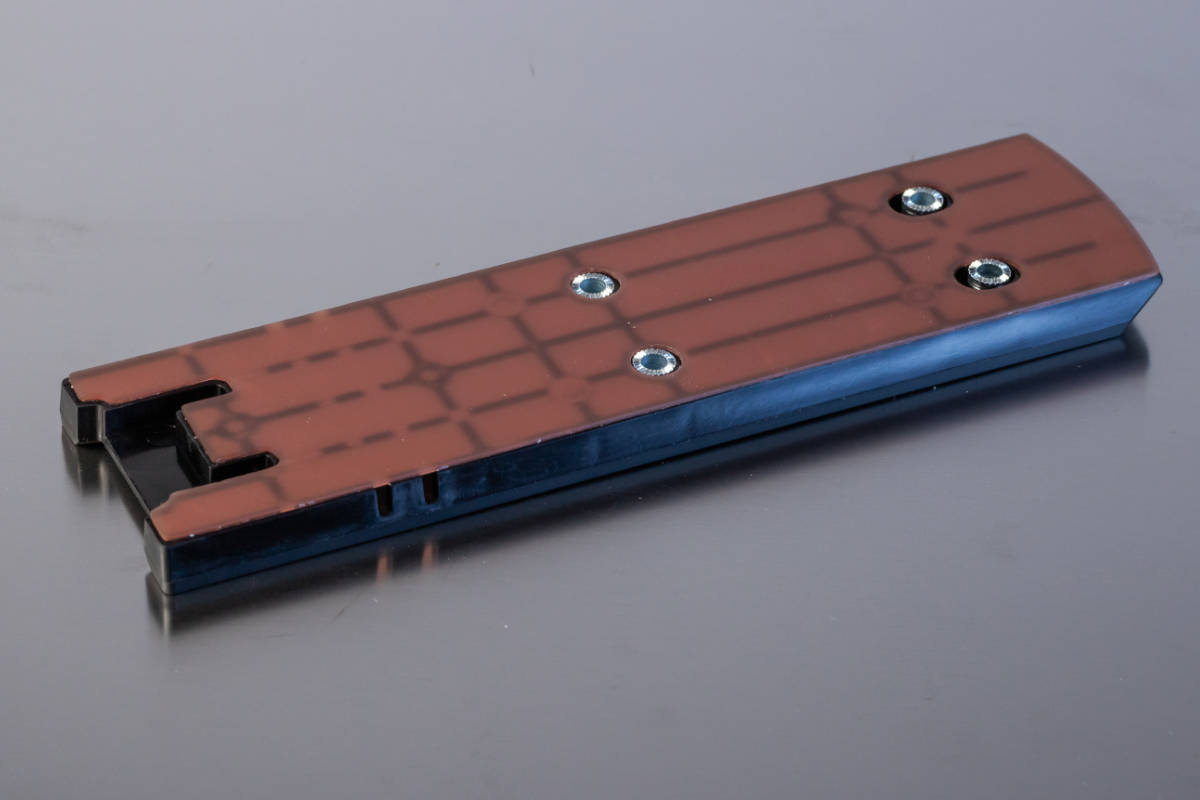
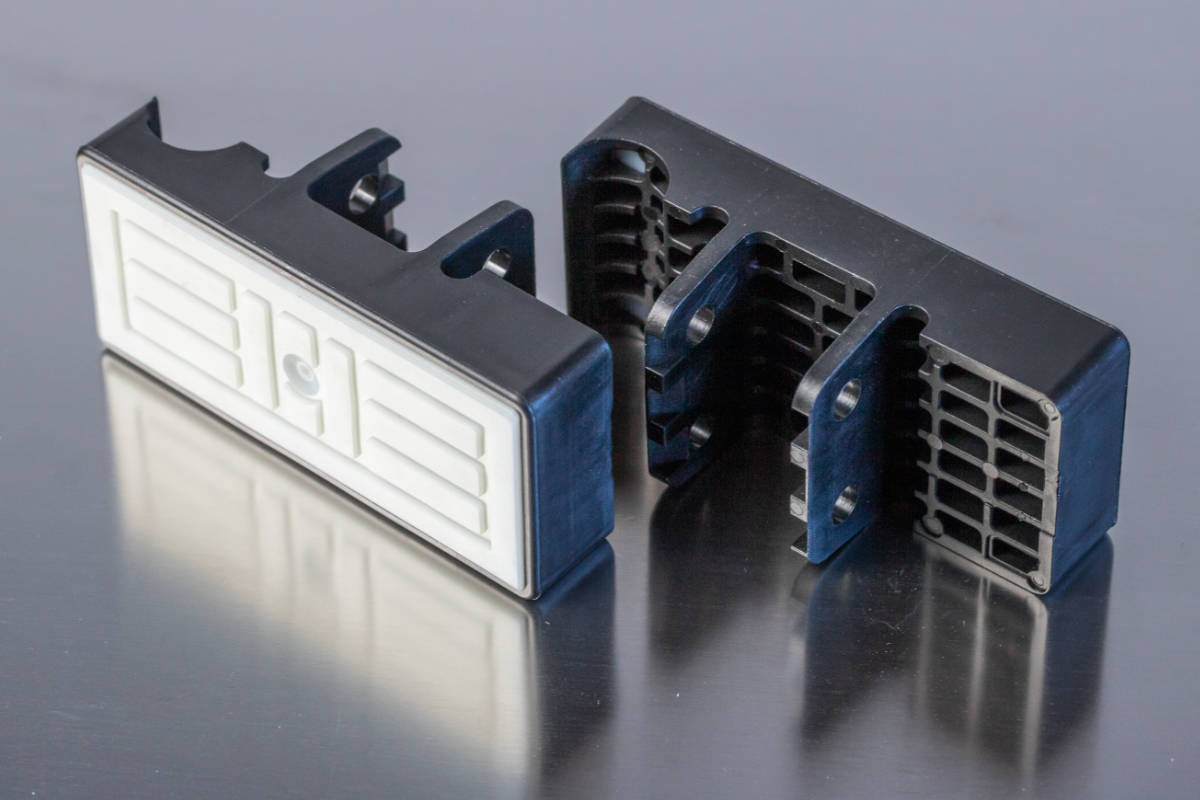
The manufacturing process
To produce two-component injection moulded parts, two different plastic granulate mixtures are required. In addition, injection moulding machines with two plasticising units are generally used. The required granulate is fed into each of these units via a hopper. The unit contains a screw conveyor: a roller with a type of thread that transports the plastic forward towards the mould. Heating bands in the plasticising unit ensure that the plastic melts (plasticises) under pressure or high temperatures and is thus homogenised.
The liquid plastic collects in the melting chamber or collection chamber, which is located at the front end of the plasticising unit and immediately behind the injection nozzle. Once this chamber is filled to the desired dosage, the injection moulding machine registers this by the increasing pressure acting on the axially flexible screw. The screw is pushed further and further back and ultimately reaches the limit switch at the rear of the plasticising unit. The conveying and dosing process is then terminated.
In the next step, the first of the two plastic mixtures for the production of multi-component injection-moulded parts is injected into the mould through the injection nozzle at a precisely calculated injection pressure. The screw is advanced either electrically or hydraulically as required. As the mass cools in the cavity of the mould, which is shaped as a negative of the part to be produced, its volume also decreases. In order to compensate for the resulting deficits and to prevent unwanted air pockets, which can ultimately weaken the two-component injection moulded parts, we initiate a re-pressing process. This involves injecting more mass into the mould, whereby the filling speed must be continuously reduced. This is followed by the cooling or heating phase (depending on the type of plastic used).
In many cases, multi-component injection moulded parts are manufactured by first processing a plastic and forming it into a so-called preform. The next plastic is then introduced, which effectively "overmoulds" the other. This is why these techniques are also referred to as overmoulding. There are various ways of doing this. For example, the cavity is first filled with the first plastic mixture, then rotated according to the desired design and filled or supplemented with the second plastic. This process is called the rotation or displacement technique.
Another option is to insert the preform made from the first plastic into the cavity of another mould and coat or fill it with the second plastic mixture. This is known as the transfer technique. In some cases, it is also possible to retract a mould core and fill the resulting cavity with the second plastic component – a process also known as core retraction technology.
What processes are available for manufacturing multi-component injection moulded parts?
When plastics of the same type but in different colours are combined in an injection-moulded part without blending into each other, this is referred to as multi-colour injection moulding. Multi-material injection moulding, on the other hand, refers to the significantly more complex processing of different materials with different functions in a single part. With our injection moulding machines, we are able to produce both hard/hard and soft/hard combinations – always in close consultation with your individual requirements, of course. Classic examples of plastic parts manufactured in this way include moulded seals, transport rollers with soft and quiet running surfaces, and MID components.
While in many cases a firm and secure connection between the individual components of a part is desired and is achieved through various adhesion parameters, certain injection-moulded parts or injection moulding require a certain amount of play between the individual parts. If this is the case, we use non-adhesive components to enable joint functions, for example, without having to rely on subsequent assembly. The production of multi-component injection moulded parts in this way is also referred to as assembly injection moulding. All three procedures, in which there is a clear separation of the two plastics used, are summarised under the umbrella term of addition processes.
If you want the exact opposite effect, namely the blending of different coloured plastics in a process known as sequence moulding, this is also possible. For example, very smooth colour transitions can be produced using the sandwich or sandwich moulding process, whereby an inner component in one colour is enclosed by an outer component in another colour. To do this, we first inject the plastic that will later be on the outside into the mould, where it spreads across the outer walls.
After demoulding, the plastic inside is then pressed into the cavity through the injection nozzle, ultimately filling the mould. Alternatively, water or gases can be introduced instead of the second plastic in this process, which then escape and leave a cavity behind. If both plastics are injected at the same time, this is referred to as co-injection. If different coloured plastics are injected alternately, this results in marbling.


